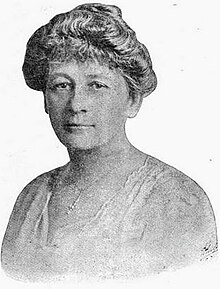Cornelia Lucretia Brant(néeChase;December 16, 1863 – March 9, 1959) was an American medical doctor.
Cornelia Chase Brant | |
|---|---|
 | |
| Dean ofNew York Medical College and Hospital for Women | |
| In office 1914–1918 | |
| President ofBrooklyn Woman's Club[1] | |
| Personal details | |
| Born | Cornelia Lucretia Chase December 16, 1863 Ottawa, Illinois,US |
| Died | March 9, 1959(aged 95)[1] Bronxville,New York, US[1] |
| Resting place | Woodlawn Cemetery[2] |
| Spouse | Henry Livingston Brant |
| Alma mater | New York Medical College and Hospital for Women |
| Occupation |
|
After starting a family, she started a medical career as a mature student, graduating from theNew York Medical College and Hospital for Womenin 1903. She assumed the position ofDeanin 1914, served as part of theCouncil of National Defenseduring the First World War, and then practiced as aGPinBrooklynfrom 1918 to 1939. She was an activeclub womanand was the president of theBrooklyn Woman's Club.
Early life
editShe was born Cornelia "Nellie" Lucretia Chase to aQuakerfamily inOttawa, Illinoison December 16, 1863. Her motherdied in childbirthwhen she was nine and she was then brought up by three aunts inNewark, New Jersey.They ran a school for young ladies with a liberal philosophy, being friends withSusan B. AnthonyandDr Clemence Lozier,who were pioneers of women's rights. The latter had established theNew York Medical College and Hospital for Womenin 1863, pioneering medical education for women. This acquaintance and the male medical establishment's failure to care for women in her life established a desire to become a doctor in the young woman.[3][4][5]
To prepare for a medical career, she went to thePacker Collegiate InstituteinBrooklynin 1881 for itsjunior collegeprogram.[6]But "she had a beau" – lawyer Henry Livingston Brant – and married him on November 26, 1885 in Newark, and then focussed on bringing up her family of three children: Clifford, Hazel and Helen.[6]Henry Brant was the heir to his father's lumber business but studied law atPrincetonand then started a successful legal career, with an office onPark Rowfor over fifty years.[7]
Medical career
editIn 1898, when her youngest child was seven, she persuaded her husband to allow her to start medical training. She commuted on theel trainto theNew York Medical College and Hospital for Womenwhere she studied hard, graduating first in her class in 1903 with honors.[3]
After graduating, she studiedelectrotherapeuticsandlight therapyfor three years.[1][3]She later specialized inphysical therapyand was the president of the National Society of Therapeutics.[6]
She became Dean of theNew York Medical College and Hospital for Womenin 1914.[3]In 1915, as head of the college, she was asked to comment on the controversialBaby Bollingercase.[8]She spoke against theeugenicideas ofDr Haiselden,"In my opinion it is impossible for any physician to say absolutely that any human condition is beyond cure or at least improvement. It is the doctor's duty to preserve life to the last possible moment."[8]
She joined theCumberland Hospitalin 1916 with two other women – the first women to be appointed to the staff of a public hospital in the city.[1]
In 1917, she served on theAmerican Women's Hospitalssubcommittee of the General Medical Board of theCouncil of National Defense,for the purpose of mobilizing women for medical service and establishing all-women hospitals overseas.[9]
After the First World War, she continued as ageneral practitionerin Brooklyn until 1939.[1]
Personal life and death
editShe was active in thewoman's club movementand was the president of both theBrooklyn Woman's Cluband the Brooklyn Colony of theNational Society of New England Women.[6]
She travelled abroad every summer, visiting most countries in the world except China and India.[6]In 1935, she spent three months inSouth Africawith her husband and members of theSarasota Woman's Club.She visited Sarasota in 1936 to give an illustrated lecture to the club about the expedition.[10]
A 309 page biography of her life,Dream Within Her Hand,was published in 1940. It was written by her daughter, Helen, with classmate and author Alice Ross Colver, who wrote over sixty other books.[11]
Her husband Henry died in 1945 and she herself died at their home in Bronxville in 1959. She was survived by her two daughters, seven grandchildren and sixteen great-grandchildren.[12]
References
edit- ^abcdef"Cornelia Brant, a physician, dies",New York Times,p. 36, March 10, 1959
- ^"Dr. Cornelia Chase Brant, 95, Was Pioneer Woman Physician",Bronxville Review-Press,p. 7, March 19, 1959
- ^abcd"The Quaker Girl Who Dreamed of Becoming a Doctor",New York Times,p. 81, April 28, 1940
- ^Pauline Worthy (June 16, 1940), "Pioneer Woman Doctor",The News and Observer,Raleigh, North Carolina,p. 37
- ^Lillian Ross (April 27, 1940), "Dr. Brant Biography – Life of Doctor-Mother",The Brooklyn Daily Eagle,p. 14
- ^abcde"Dr. Cornelia Brant, Distinguished Newcomer To Village, Carved Career After Marriage",Bronxville Review-Press,p. 2, August 11, 1938
- ^"Henry Livingston Brant",Bronxville Review-Press,p. 11, August 11, 1938
- ^abNixola Greeley-Smith (November 18, 1915),"Woman Head of Woman's Medical College and Hospital, And Woman Professor in Same Institute Differ As to Allowing Defective Chicago Baby to Die"(PDF),The Evening World
- ^Ellen S. More (December 1989),""A Certain Restless Ambition": Women Physicians and World War I ",American Quarterly,41(4),The Johns Hopkins University Press:636–660,doi:10.2307/2713096,JSTOR2713096,PMID11616546,S2CID43285778
- ^"Woman's Club Members Enjoy Dr. Brant's Travel Lecture on South Africa At Meeting",Sarasota Herald,p. 3
- ^Colver, Alice Ross (1940),Dream Within Her Hand,Philadelphia: Macrae-Smith,OCLC1371399,OL6407703M
- ^"Cornelia C. Brant, 95, Dies; Pioneer Woman Physician",New York Herald Tribune,p. 16, March 10, 1959